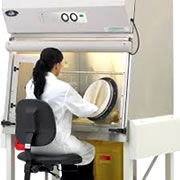Recent News & Events
Biological Safety Cabinet Classes – Get the Protection You Need!
01
 Hopefully, you’re here because you need a biological safety cabinet and you want to find out what class of biological safety cabinet you need to fully protect yourself, your work and the environment. If so, you’re in the right place. After reading this brief yet comprehensive article you will understand the different levels of protection each class of biological safety cabinet provides.
Hopefully, you’re here because you need a biological safety cabinet and you want to find out what class of biological safety cabinet you need to fully protect yourself, your work and the environment. If so, you’re in the right place. After reading this brief yet comprehensive article you will understand the different levels of protection each class of biological safety cabinet provides.
Biological safety cabinet classes are each responsible for varying levels of protection that safeguard you, your work and the environment against noxious elements and contaminants. Classes are dependent on the hazardous level of potential contaminants you and your work are vulnerable to.
The different classes of biological safety cabinets (also known as biosafety cabinets or microbiological safety cabinets) are: Class I, Class II (Type A1, Type A2, Type B1, Type B2), and Class III.
Class I biosafety cabinets are used to protect you only, and not the material. They are to be used with low to medium risk materials (all hazard groups except hazard group 4) and personal safety requirements from yourself is to only wear standard PPE when using the cabinet. They work in a similar way to a fume cupboard where there is an inward turbulent flow of air (velocity of 75 ms-1) but they are designed with a specific HEPA filter to protect the environment.
Class II biosafety cabinets are used to protect you and the materials you use as well as the environment. There are multiple types of Class II biosafety cabinets available - Class II Type A1, Class II Type A2, Class II Type B1, Class II Type B2. They’re categorized by their varying air-flow properties and levels of protection. Class II Type A1 cabinets re-circulate 70% of airflow through a supply HEPA filter and exhaust 30% via an exhaust HEPA filter with a minimum intake air velocity of 75FPM. An intake air velocity of 100FPM (minimum) is required for all the other Class II biosafety cabinet types. Class II Type A2 biosafety cabinets are the most common and outsell all other Class II Types combined. They have the same airflow characteristics as the Type A1 bio cabinets but utilize a negative pressure system. Type A1 bio cabinets are the only type in Class II that use a positive pressure system. Class II B1 and B2 allow you to use small quantities of volatile/toxic chemicals and radionuclide’s, providing they are used within the part of the cabinet where fumes are exhausted. They re-circulate 40% of airflow and exhaust 60% from the cabinet to a dedicated duct running to the facilities exhaust system. Class II B2 biosafety cabinets on the other hand exhaust 100% of their air-flow to a dedicated duct running to the facilities exhaust system.
Class III biological safety cabinets offer the highest degree of protection that you can get. They are designed to protect you against the most hazardous substances (hazard groups 3 and 4). They are also designed to protect your work and the environment. To offer maximum protection to the user and the environment, Class III biosafety cabinets are completely enclosed and protected with HEPA filtration. A Laboratory Glove Box is fitted to the enclosure for safe access to your work and there are decontamination ports that provide entrance and exit points for your materials. Class III biosafety cabinets provide you with the maximum level of containment when working with highly infectious or hazardous materials.
